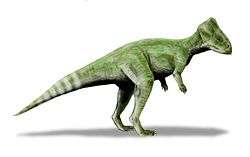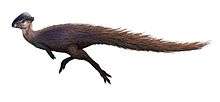Graciliceratops
| Graciliceratops Temporal range: Late Cretaceous, 90 Ma | |
|---|---|
 | |
| Artist's impression | |
| Scientific classification | |
| Kingdom: | Animalia |
| Phylum: | Chordata |
| Class: | Reptilia |
| Clade: | Dinosauria |
| Order: | †Ornithischia |
| Family: | †Protoceratopsidae |
| Genus: | †Graciliceratops |
| Type species | |
| Graciliceratops mongoliensis Sereno et al., 2000 | |
Graciliceratops (meaning 'graceful horned face') is a small ceratopsian dinosaur originally described by Maryanska and Osmólska in 1975 and referred to Microceratops gobiensis.[1] It was later redescribed as a new genus and species by Paul Sereno in 2000.[2] It is known from the Late Cretaceous period and its fossils were found in Mongolia. Only a partial skeleton has been found. The type (and only known) species is Graciliceratops mongoliensis.
Graciliceratops is known from Shireegiin Gashuun in Mongolia's Gobi Desert, north of the Nemegt Basin. The Shireegiin Gashuun locality is thought to be older than the Djadokhta localities that produced Protoceratops, and is probably early Late Cretaceous in age.[1] The relationships of the genus are unclear, however the frill has large fenestrae bounded by very slender struts. This structure is very similar to that of the later Protoceratops.[2]
The skull of the animal measures an estimated twenty centimetres,[1] and the whole animal would have been about the size of a cat. However, the arches and bodies of the vertebrae are not fused, which suggests that the animal was not fully grown when it died. The adult may have approached Protoceratops in size, which grew to around two meters.[2]
Like other ceratopsians, Graciliceratops would have been an herbivore, using its powerful beak and shearing teeth to process tough plant matter. Little is known about the flora of the ancient Gobi Desert, and so it is unclear what it would have eaten.
See also
References
External links
| Cretaceous Period | |
|---|---|
| Lower/Early Cretaceous | Upper/Late Cretaceous |
| Berriasian | Valanginian | Hauterivian Barremian| Aptian | Albian |
Cenomanian | Turonian | Coniacian Santonian |Campanian | Maastrichtian |


